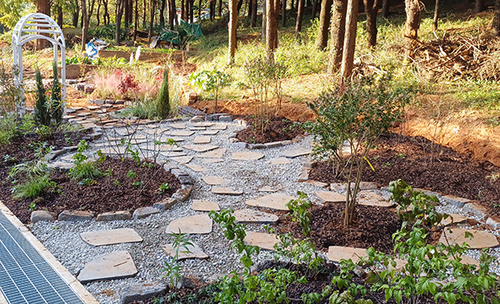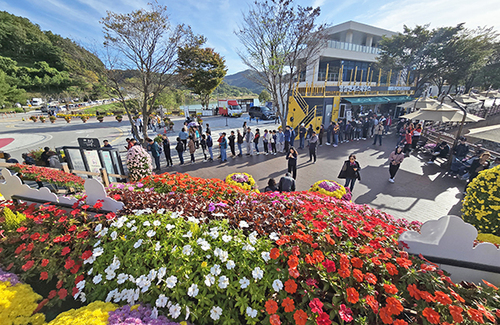| в–І мӮјкөӯ~нҶөмқјмӢ лқјмӢңлҢҖ м ‘кІҪм§Җм—ӯмңјлЎң мҳҒнҶ (м„ёл Ҙ)нҷ•мһҘмқ„ мң„н•ң мҡ”충м§ҖмҳҖмқҢмқ„ л°ҳмҰқн•ҳкі мһҲлҠ” м „л¶Ғ л¬ҙмЈј 'лӢ№мӮ°лҰ¬ лҙүнҷ”мң м Ғ'мқҳ ліҙмЎҙ л°Ҹ кҙҖлҰ¬лҘј мң„н•ҙ л¬ёнҷ”мһ¬ м§Җм •мқҙ н•„мҡ”н•ҳлӢӨлҠ” мқҳкІ¬мқҙ лҳҗлӢӨмӢң м ңкё°лҗЁм—җ л”°лқј лҸ„(йҒ“) л¬ёнҷ”мһ¬ м§Җм • мӢ мІӯ л“ұ кҙҖлҰ¬м—җ лҸҢмһ…н–ҲлӢӨ. / мӮ¬м§„м ңкіө = л¬ҙмЈјкө°мІӯ © мқҙмӨҖнҷҳ кё°мһҗ |
|
мӮјкөӯ~нҶөмқјмӢ лқјмӢңлҢҖ м ‘кІҪм§Җм—ӯмңјлЎң мҳҒнҶ (м„ёл Ҙ)нҷ•мһҘмқ„ мң„н•ң мҡ”충м§ҖмҳҖмқҢмқ„ л°ҳмҰқн•ҳкі мһҲлҠ” м „л¶Ғ л¬ҙмЈј 'лӢ№мӮ°лҰ¬ лҙүнҷ”мң м Ғ'мқҳ ліҙмЎҙ л°Ҹ кҙҖлҰ¬лҘј мң„н•ҙ л¬ёнҷ”мһ¬ м§Җм •мқҙ н•„мҡ”н•ҳлӢӨлҠ” мқҳкІ¬мқҙ м ңкё°лҗҗлӢӨ.
л¬ҙмЈјкө°мқҖ "'лӢ№мӮ°лҰ¬ лҙүнҷ”мң м Ғ'мқҙ н•ҷмҲ м Ғ к°Җм№ҳмҷҖ л¬ёнҷ”мһ¬м Ғ ліҙмЎҙ к°Җм№ҳк°Җ лҶ’лӢӨлҠ” нҸүк°Җм—җ л”°лқј лҸ„(йҒ“) л¬ёнҷ”мһ¬ м§Җм • мӢ мІӯ л“ұ кҙҖлҰ¬м—җ лҸҢмһ…н–ҲлӢӨ"кі 20мқј л°қнҳ”лӢӨ.
л¬ҙмЈјкөӯмң лҰјкҙҖлҰ¬мҶҢ мӮ°л¶Ҳмў…н•©нӣҲл ЁмһҘмқҙ мһҲлҠ” н•ҙл°ң 429.6mмқҳ м•јмӮ° м •мғҒл¶ҖлҘј л‘ҳлҹ¬мӢј м„қ축과 лҙүнҷ”лЎң м¶”м •лҗҳлҠ” м„қ축мӢңм„Өмқҙ нҷ•мқёлҗҗлӢӨ.
м§ҖлӮңн•ҙ 10мӣ” м „л¶Ғм§Җм—ӯ к°Җм•јл¬ёнҷ”мң мӮ° л°ңкөҙ л°Ҹ м •л№„мӮ¬м—… мқјнҷҳмңјлЎң мӢӨмӢңн•ң м •л°Җм§Җн‘ңмЎ°мӮ¬ кІ°кіј, мӮ°мқҳ лҠҘм„ мқ„ л”°лқј 분нҸ¬н•ҳкі мһҲлҠ” 3кё°мқҳ лҙүнҷ”лҢҖ(лҙүнҷ”м¶”м •м§Җ)мҷҖ лҙүнҷ”лҢҖ мЈјліҖм—җ л¶Җ분м ҒмңјлЎң мЎ°м„ұлҗң м„ұлІҪ(м„қ축방нҳёлІҪ)мқ„ нҷ•мқён–ҲлӢӨ.
мЎ°мӮ¬кІ°кіј лҙүнҷ”лҢҖлЎң м¶”м •лҗҳлҠ” лҸҷ-м„ң м•Ҫ 6.9mгҶҚлӮЁ-л¶Ғ м•Ҫ 7mмқҳ м •л°©нҳ•м—җ к°Җк№Ңмҡҙ м„қ축мӢңм„Өмқҳ кө¬мЎ°мҷҖ нҳ•нғңк°Җ нҷ•мқёлҗҗкі м„қ축мӢңм„Ө м•„лһҳм—җ м„қ축мқ„ ліҙк°•н•ҳкё° мң„н•ҙ кі„лӢЁмӢқмңјлЎң мҢ“мқҖ ліҙ축л¶Җк°Җ мқјл¶Җ лӮЁм•„ мһҲлӢӨ.
лҳҗ мң м Ғмқҳ м„ұкІ© к·ңлӘ… л°Ҹ ліҙмЎҙкіј м •л№„лҘј мң„н•ҙ 추к°Җ мЎ°мӮ¬к°Җ н•„мҡ”н•ҳлӢӨлҠ” н•ҷмҲ мһҗл¬ёнҡҢмқҳ кІ°кіјлҘј к·јкұ°лЎң м§ҖлӮң 5мӣ” 2м°Ё мӢңкөҙ кІ°кіј, мЎ°мӮ¬лҗң 2нҳё лҙүнҷ”лҠ” м •л°©нҳ•м—җ к°Җк№Ңмҡҙ м„қ축лӢЁкіј ліҙ축лӢЁмқҙ кі„лӢЁмӢқмңјлЎң мЎ°м„ұлҗң нқ”м Ғмқҙ л°ңкІ¬лҗҗлӢӨ.
лӢ№мӢң, нҳ„мһҘмқ„ л°©л¬ён•ң мһҗл¬ёмң„мӣҗл“ӨмқҖ лӢ№мӮ°лҰ¬ лҙүнҷ”мң м ҒмқҖ лҙүнҷ”лҢҖ 3кё°гҶҚ집мҲҳмӢңм„ӨгҶҚл°©нҳём„қ축 л“ұмқ„ к°–м¶ҳ кҙҖл°©мң м ҒмңјлЎң к·ё нҳ•нғңмҷҖ кө¬мЎ° л“ұмқҙ м•„м§Ғк№Ңм§Җ нҷ•мқёлҗҳм§Җ м•Ҡм•ҳлҚҳ лҸ…нҠ№н•ң мҡ”мҶҢлЎң нҷ•мқёлҸј н•ҷмҲ м Ғ к°Җм№ҳк°Җ л§Өмҡ° лҶ’лӢӨкі нҸүк°Җн–ҲлӢӨ.
лҳҗн•ң 1~2нҳё лҙүнҷ”мқҳ кё°мҙҲл¶Җм—җм„ң мӮјкөӯмӢңлҢҖ нҶ кё°нҺёмқҙ м¶ңнҶ лҸј 축조 мӢңкё°лҘј к°ҖлҠ н• мҲҳ мһҲлҠ” мһҗлЈҢлҸ„ нҷ•ліҙлҗҗлӢӨ.
3нҳё лҙүнҷ”м—җ лҢҖн•ң м •л°Җ л°ңкөҙмЎ°мӮ¬лҘј мӢӨмӢңн•ҙ м •нҷ•н•ң мң м Ғмқҳ м„ұкІ© л°Ҹ кө¬мЎ° л“ұмқ„ нҢҢм•…н• н•„мҡ”к°Җ мһҲлӢӨлҠ” мқҳкІ¬лҸ„ м ңмӢңлҗҳкі мһҲлӢӨ.
м¶ңнҶ лҗң мң л¬јмқҖ мӮјкөӯ~нӣ„л°ұм ңмӢңкё° нҶ кё°нҺёл“ӨлЎң мөңк·ј л°ңкөҙмЎ°мӮ¬к°Җ 진н–үлҗҳкі мһҲлҠ” м „л¶Ғ лҸҷл¶Җ мӮ°к°„м§Җм—ӯ лҙүнҷ”мң м Ғл“Өкіј лҸҷмқјн•ң м–‘мғҒмңјлЎң 2нҳё лҙүнҷ”мқҳ кІҪмҡ°, мһҗм—°м•”л°ҳмқ„ көҙм°©н•ҳкі м„қмһ¬лҘј лҚ§лҢҖм–ҙ 축조н•ң кІғмңјлЎң нҷ•мқёлҗҗлӢӨ.
нҠ№нһҲ мӢңкөҙмЎ°мӮ¬ лӢ№мӢң мһҘл°©нҳ• нҳ•нғңлЎң м¶”м •лҗҗмңјлӮҳ л°ңкөҙмЎ°мӮ¬ кІ°кіј, м—°лҜёнҳ•(зҮ•е°ҫеҪў = м ң비꼬лҰ¬ лӘЁм–‘) лҸҢм¶ңл¶ҖлҘј к°–м¶ҳ мң мӮ¬н•ң лҸ…нҠ№н•ң нҠ№м§•мқ„ ліҙмқҙлҠ” л“ұ м–‘лҒқ лӢЁм—җ лҸҢм¶ңлҗң м„қ축мқ„ лҚ§лҢҖм–ҙ л°©нҳём„қ축과 м—°кІ°лҗҳлҠ” кө¬мЎ°лҘј ліҙмқҙкі мһҲлӢӨ.
лҙүнҷ”лЎң мқҙмҡ©лҗҳлӢӨ м„ұлІҪкіј л§қлҢҖ л“ұмқ„ к°–м¶ҳ ліҙлЈЁ л“ұмқҳ кё°лҠҘмңјлЎң ліҖнҷ”лҗҗмқ„ к°ҖлҠҘм„ұмқҙ м ңмӢңлҗҳл©ҙм„ң лӢ№мӢң м җкұ°н•ҳлҚҳ м„ёл Ҙм—җ мқҳн•ҙ мң м Ғмқҳ кё°лҠҘмқҙ ліҖнҳ•лҗҗмқ„ к°ҖлҠҘм„ұ м—ӯмӢң м ңкё°лҗҗлӢӨ.
л¬ҙмЈјкө° мһ„м •нқ¬ л¬ёнҷ”мһ¬нҢҖмһҘмқҖ "лӢ№мӮ°лҰ¬ лҙүнҷ”мң м Ғмқҳ мЎ°мӮ¬ м„ұкіјлҘј нҶөн•ҙ н•ҷмҲ м Ғ к°Җм№ҳмҷҖ л¬ёнҷ”мң мӮ°мқ„ нӣ„мҶҗл“Өм—җкІҢ л¬јл ӨмЈјкё° мң„н•ҙ ліҙмЎҙкіј кҙҖлҰ¬мқҳ н•„мҡ”м„ұмқҙ мһ¬нҷ•мқёлҗҗлӢӨ"л©° "л¬ёнҷ”мһ¬ м§Җм •мқ„ лӘ©н‘ңлЎң мң м Ғл“Өмқҙ мІҙкі„м ҒмңјлЎң ліҙмЎҙкіј кҙҖлҰ¬к°Җ мқҙлӨ„м§Ҳ мҲҳ мһҲлҸ„лЎқ мөңм„ мқҳ л…ёл Ҙмқ„ лӢӨн•ҳкІ лӢӨ"кі л§җн–ҲлӢӨ.
к·ёлҹ¬л©ҙм„ң "лӮҙл…„м—җлҠ” н•„мҡ”н•ң л°ңкөҙмЎ°мӮ¬мҷҖ н•Ёк»ҳ л¬ён—ҢкІҖнҶ л°Ҹ мЈјліҖ мң м Ғмқҳ м—°кҙҖм„ұкіј нғҖ м§Җм—ӯ лҙүнҷ”мң м Ғкіј 비көҗ л“ұ 'лӢ№мӮ°лҰ¬ лҙүнҷ”мң м Ғ'мқҳ н•ҷмҲ м Ғ к°Җм№ҳлҘј мһ¬м •лҰҪн• мҲҳ мһҲлҠ” н•ҷмҲ лҢҖнҡҢлҘј кі„нҡҚн•ҳкі мһҲлӢӨ"кі лҚ§л¶ҷмҳҖлӢӨ.
вҳһ м•„лһҳлҠ” мң„ кё°мӮ¬лҘј кө¬кёҖ лІҲм—ӯмқҙ лІҲм—ӯн•ң мҳҒл¬ё кё°мӮ¬мқҳ 'м „л¬ё' мһ…лӢҲлӢӨ.
кө¬кёҖ лІҲм—ӯмқҖ мқҙн•ҙлҸ„лҘј лҶ’мқҙкё° мң„н•ҙ л…ёл Ҙн•ҳкі мһҲмңјл©° мҳҒл¬ё лІҲм—ӯм—җ мҳӨлҘҳк°Җ мһҲмқҢмқ„ м „м ңлЎң н•©лӢҲлӢӨ.
гҖҗBelow is the 'full text' of the English article translated by Google Translate.
Google Translate is working hard to improve understanding, and assumes that there are errors in the English translation.гҖ‘
Started preservation and management of 'Dangsan-ri Bonghwa Relic' in Muju-gun
Check the protective stone shaftвҖҰ Hosting academic conferences and promoting provincial cultural heritage designation
Reporter Junhwan Lee
An opinion has been raised that it is necessary to designate as a cultural property for the preservation and management of 'Dangsan-ri Bonghwa Ruins' in Muju, Jeollabuk-do, which proves that it was a key point for territorial (power) expansion to the border area of the Three Kingdoms and Unified Silla Period.
Muju-gun announced on the 20th that "Dangsan-ri Bonghwa Ruins" has been evaluated as having high academic value and cultural preservation value, and has begun management, including application for designation as a provincial cultural property.
Stoneworks surrounding the top of the mountain at an altitude of 429.6m, where the forest fire training center of the Muju National Forest Management Office is located, and stonework facilities presumed to be beacons have been confirmed.
As a result of a precise index survey conducted as part of the excavation and maintenance project of Gaya cultural heritage in the Jeonbuk region in October of last year, three beacon towers (Bonghwa Chujeongji) distributed along the ridge of the mountain and a partially constructed fortress wall (stonework protection wall) around the beacon tower were found. Confirmed.
As a result of the investigation, the structure and shape of the stonework facility, which is estimated to be about 6.9m east-west and about 7m south-north, which is estimated to be Bonghwadae, was confirmed.
In addition, based on the results of the academic advisory meeting that additional investigations are needed for the characterization of the remains and preservation and maintenance, as a result of the second round of prospecting in May, the beacon No. this was found
At that time, the advisory committee members who visited the site evaluated the Dangsan-ri beacon site as having a very high academic value as it was identified as a unique element whose shape and structure had not yet been confirmed as a government defense site equipped with three beacon towers, water collection facilities, and protective stone walls.
In addition, pieces of pottery from the Three Kingdoms period were excavated from the base of Beacon Fires No. 1 and 2, providing data to estimate the construction period.
There is also an opinion that it is necessary to conduct a detailed excavation investigation on Beacon No. 3 to understand the exact nature and structure of the remains.
The excavated artifacts are earthenware pieces from the Three Kingdoms ~ Later Baekje period. In the case of Beacon No. 2, it was confirmed that it was built by excavating natural bedrock and adding stones in the same way as the remains of beacon fires in the mountainous area of eastern Jeonbuk, where excavation research is currently underway.
In particular, at the time of the trial excavation, it was estimated to be in a rectangular shape, but as a result of the excavation investigation, it showed a similar unique feature with a tail-shaped(зҮ•е°ҫеҪў = swallow tail) protrusion.
As the possibility that it was used as a beacon and changed to a function such as a fort equipped with a castle wall and a watchtower was suggested, the possibility that the function of the ruins was changed by the occupying forces at the time was also raised.
Lim Jung-hee, cultural heritage team leader of Muju-gun, said, "Through the results of the investigation of the Bonghwa ruins in Dangsan-ri, the need for preservation and management has been reaffirmed in order to pass down the academic value and cultural heritage to descendants." We will do our best to make it happen," he said.
He added, "Next year, we are planning an academic conference to redefine the academic value of the 'Dangsan-ri Bonghwa Remains', such as reviewing the literature along with the necessary excavation research, the relevance of the surrounding ruins, and comparison with the Bonghwa Relics in other regions."




 м»Өл®ӨлӢҲнӢ°
м»Өл®ӨлӢҲнӢ°  н”јн”Ң
н”јн”Ң  лҸ…мһҗнҲ¬кі
лҸ…мһҗнҲ¬кі
















 л§Һмқҙ ліё лүҙмҠӨ
л§Һмқҙ ліё лүҙмҠӨ











